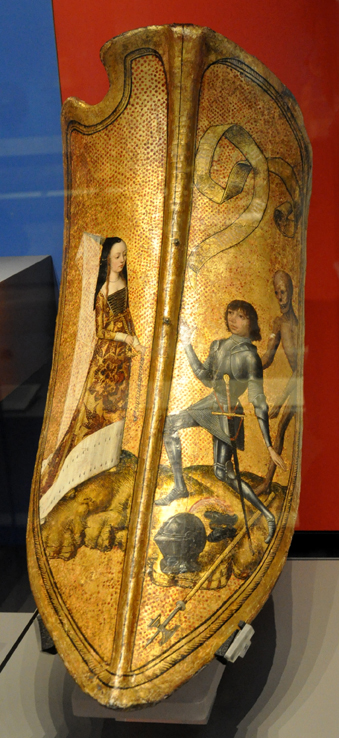The Power institute is proud to present in partnership with the Italian Cultural Institute, Sydney, the forthcoming free symposium titled ‘Of Loves and Ladies, Knights and Arms’: The Renaissance Effect.
When we think of Renaissance art, we may think of individual examples of great painting and sculpture, but these works were often planned within complex decorative ensembles. In this afternoon of four diverse talks, notable Italian scholars and curators will explore concepts of decoration, luxury and utility in the Renaissance and bring to our attention many fascinating objects and decorative schemes of the 15th and 16th centuries and their modern afterlives.
Speakers and Abstracts
Massimo Ciavolella | Director of the Center for Medieval and Renaissance Literature, UCLA, Los Angeles
Luxury and Pageantry for representation of Ariosto “I suppositi” in 1509 Ferrara
Alessandro della Latta | Guest researcher at the Gemäldegalerie museum, Berlin
Heroic Shields Wars and their literary and artistic fictions established the image of the Prince as Condottiere, as the wonderful Cosimo I in armour portrayed around 1545 by Agnolo Bronzino, now in the Art Gallery of New South Wales. Reproduced in paintings, worn in festivals, wedding ceremonies and tourneys, armours and parade shields had a valuable meaning for a characterization of the princes, often bearing devices (imprese) and showing elaborated iconographies. Aim of this paper is to show how them were connected with ancient and contemporary epic poems or inspired by them.
Marxiano Melotti | Professor of Sociology of Tourism and Heritage, Niccolo Cusano University, Rome
What is Renaissance today? There are not only museums of great tradition, elegant palaces and sophisticated collectors providing a form of continuity with the past. Even in Italy the marketing has taken possession of the Renaissance, which is increasingly used as an effective tool for theming: hotels, shopping centers and festivals of living history are profoundly changing our image of this age. The paper will present some examples of this imaginative tourist and commercial reinvention of the Renaissance, which hybrids history, culture and market.
Annalisa Zanni | Director, Poldi Pezzoli Museum, Milan
Luxury as Propaganda Precious and sumptuous decorative arts were in the Italian Renaissance courts far more than a status symbol, as in the modern sense. Focusing on some case studies and prominent artefacts from the 15th and 16th century commissioned in north Italian courts as the Sforzas, the Gonzagas and the Estes, we will suggests as silver- and goldsmith, textiles, maiolicas and many other ‘minor arts’ expressed magnificence, were symbols of politic power, and reflected the technical skill and artistic inventiveness of the Italian workshops.
Biographies
Massimo Ciavolella is Director of the Center for Medieval and Renaissance Literature, UCLA, Los Angeles. He was the co-founder and co-editor (1970-1991) of Quaderni d’italianistica (the official journal of the Canadian Society for Italian Studies) and he is currently co-editing “Lorenzo Da Ponte Italian Library,” a University of Toronto Press collection of 100 Italian major texts translated to English. Author of a broad stream of articles, reviews, encyclopaedia and dictionary entries, etc., he has also written and co-edited several books, including most recently Ariosto Today. Contemporary Perspectives (Toronto University Press, 2003) and Culture and Authority in the Baroque (Toronto University Press, 2005).
Alessandro della Latta is a guest researcher at the Gemäldegalerie museum, Berlin and scientific consultant to the SUM Foundation in Milan and Florence. della Latta has been a post-doctoral fellow at the Kusthistorisches Institut in Florence, at the Stiftung Preussischer Kulturbesitzt in Berlin, and a lecturer at the Istituto Italiano di Scienze Umane in Florence. He collaborates with several Italian and European museums. The interdisciplinary approach of his research, connecting literature, philology and visual arts, has led him to become a member of research projects at the Scuola Normale Superiore in Pisa. His published works include studies on Imprese as symbolic portraits and on decorative arts. He is preparing a book on artist’s signatures in Florentine Renaissance.
Marxiano Melotti works on the relationships between religious rites, cultural memory and tourism. He is Professor of Sociology of Tourism and Heritage at Niccolo Cusano University, Rome and the Secretary general of the Foundation for the Italian Institute of Human Sciences (SUM). His published works include The Plastic Venuses. Archaeological Tourism and Post-Modern Society (Cambridge Scholars, Newcastle, 2011), Turismo archeologico (Bruno Mondadori, Milano 2008), Mediterraneo tra miti e turismo (Cuem, Milano 2007).
Annalisa Zanni is Director of the Poldi Pezzoli Museum. Since 1992 she has been involved in the new installation of the Armoury by Arnaldo Pomodoro. Recently she has devised important exhibitions and focussed on enhancing the collection and securing donations to the Museum, as well as supporting the study and research of private collecting in Lombardy and Italy. Since1992-1993 she has been teaching the history of Goldsmith’s Art at the postgraduate History of Art at the Università Cattolica del Sacro Cuore in Milan. She has written on Renaissance painting and jewellery and the history of taste in 19th century, furniture, furnishings and jewellery as well as contributing many museum exhibition essays. In 2011 she received the most important dignity of Milan, the Ambrogino d’oro, for her important role devoted to the culture of the city.
REGISTRATION WILL OPEN 7 FEBRUARY – see website for further detail
The symposium is co-presented with the Istituto Italiano di Cultura, Sydney.
Venue: Woolley Commmon Room, Level 4, John Woolley Building A20, Science Road, University of Sydney
Contact: Susan Thomas Email: powerinstitute.events@sydney.edu.au

